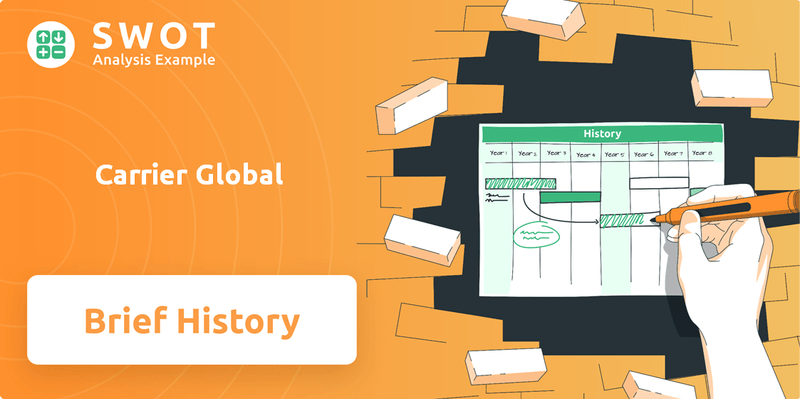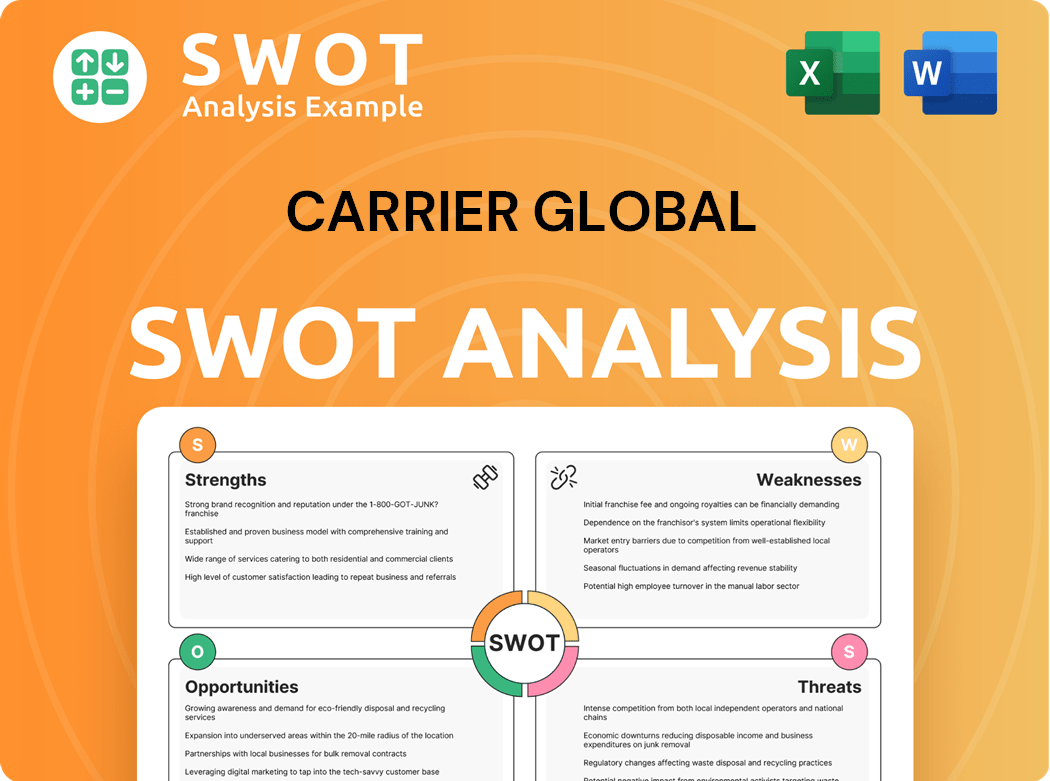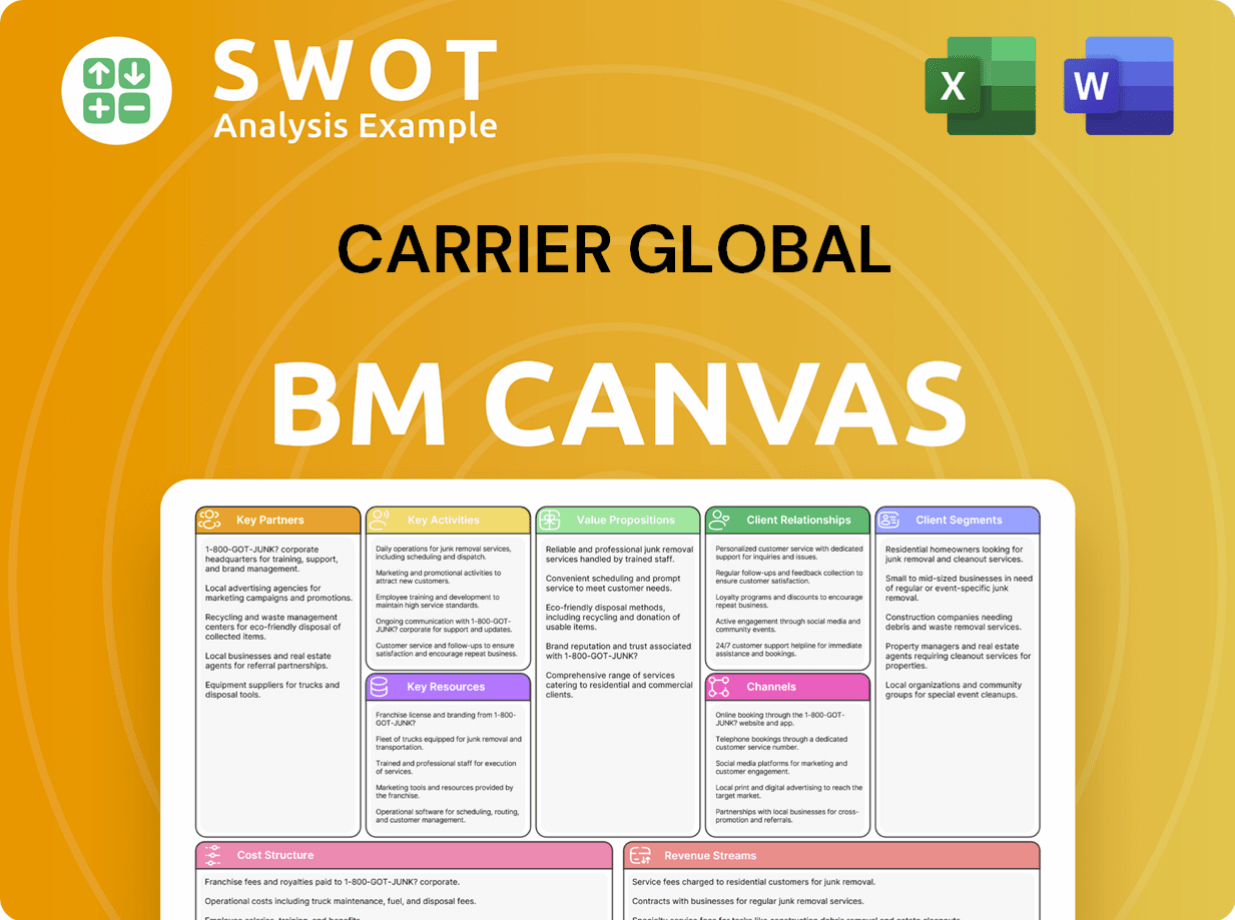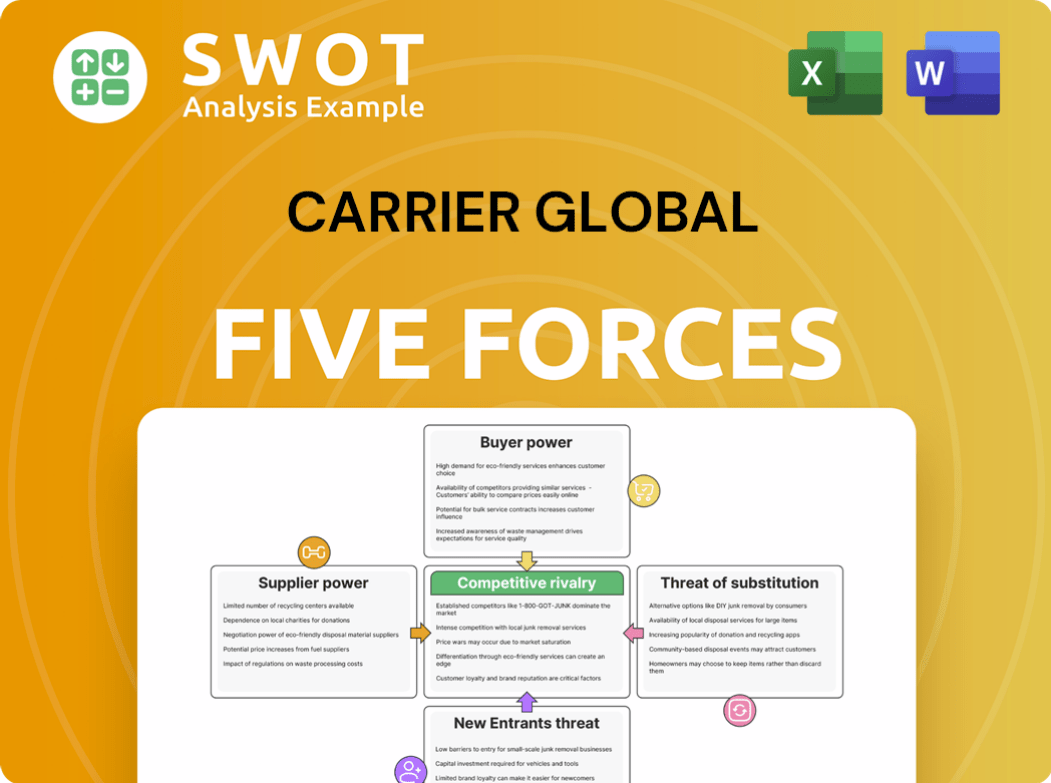Carrier Global Bundle
How did Carrier Global revolutionize comfort and climate control?
The story of modern comfort begins with a single invention: air conditioning. This innovation paved the way for Carrier Global SWOT Analysis, a company that has fundamentally reshaped the HVAC industry. Founded in 1902 by Willis Carrier, the company initially aimed to control indoor environments, a radical concept at the time.

From solving industrial humidity problems, Carrier Global has grown into a global leader, offering innovative solutions in HVAC, refrigeration, and building automation. Understanding the brief history of Carrier Global Corporation reveals a journey from a singular invention to a diversified enterprise. This article will explore Carrier's evolution, highlighting its impact on the built environment and its commitment to sustainability, shaping the HVAC market.
What is the Carrier Global Founding Story?
The story of Carrier Global Corporation begins with a pivotal invention in 1902. Willis Carrier, an engineer, created the 'Apparatus for Treating Air,' which would revolutionize climate control. This invention laid the groundwork for a company that would become a leader in the HVAC industry.
Carrier's innovation addressed a specific challenge: the fluctuating humidity in a printing plant that was causing issues with the printing process. This led to the development of systems that precisely controlled temperature and humidity. This focus on industrial applications set the initial course for the company.
The formal establishment of the company occurred on June 26, 1915. Willis Carrier, along with six other engineers, pooled resources to create the Carrier Engineering Corporation. This marked a significant step towards independence and growth within the burgeoning HVAC industry.
Willis Carrier's invention in 1902 was the genesis of what would become Carrier Global. The company was officially founded in 1915, marking its independence.
- Willis Carrier invented the 'Apparatus for Treating Air' in 1902.
- The initial focus was on providing air conditioning solutions for industrial applications.
- Carrier Engineering Corporation was established in 1915 with $32,600 in capital.
- The early 20th century's industrial growth fueled the demand for Carrier's technology.
The company's early years were marked by innovation and a focus on solving specific industrial challenges. The demand for controlled environments grew alongside industrialization, which helped Carrier's early success. The company's ability to provide custom-engineered solutions set it apart in the market. To understand the competitive landscape, consider the Competitors Landscape of Carrier Global.
Carrier Global SWOT Analysis
- Complete SWOT Breakdown
- Fully Customizable
- Editable in Excel & Word
- Professional Formatting
- Investor-Ready Format

What Drove the Early Growth of Carrier Global?
The early growth of Carrier Global was marked by a strategic shift from industrial applications to comfort cooling, significantly expanding its market reach. This expansion was fueled by innovative technology and a growing recognition of the benefits of air conditioning. Key milestones in this period included pioneering installations in public spaces and the development of groundbreaking technologies.
In 1924, Carrier Global installed air conditioning in the Hudson Department Store in Detroit, marking an early foray into human comfort. The Rivoli Theatre in New York City followed in 1925, showcasing the technology's applicability in public venues. These projects helped establish the company within the burgeoning HVAC industry and demonstrated its potential beyond industrial settings.
A pivotal innovation was the centrifugal chiller, developed in 1922, which made large-scale air conditioning practical and affordable. This invention significantly accelerated the adoption of air conditioning in commercial buildings, driving Carrier history forward. This innovation was critical to the company's early success.
During the 1930s, Carrier company expanded its product line to include residential air conditioning units, making comfort cooling accessible to homes. Simultaneously, the company began its international expansion, entering markets in Japan and Europe. This diversification and global reach were key to its early growth.
Willis Carrier remained a central figure, emphasizing engineering excellence and innovation. The competitive landscape was still developing, with Carrier Global often pioneering new technologies. Strategic focus was on diversifying applications and solidifying its position as a leader in the industry.
Carrier Global PESTLE Analysis
- Covers All 6 PESTLE Categories
- No Research Needed – Save Hours of Work
- Built by Experts, Trusted by Consultants
- Instant Download, Ready to Use
- 100% Editable, Fully Customizable

What are the key Milestones in Carrier Global history?
The Carrier Global Corporation's journey is marked by significant milestones that have reshaped the HVAC industry. From pioneering air conditioning technologies to strategic business moves, its history reflects a commitment to innovation and adaptation. A detailed look at the Growth Strategy of Carrier Global reveals the company's evolution and its impact on the market.
| Year | Milestone |
|---|---|
| 1922 | Development of the centrifugal chiller, revolutionizing large-scale air conditioning. |
| 1928 | Introduction of the first residential air conditioner, bringing comfort cooling to homes. |
| 2020 | Spin-off from United Technologies, allowing focused investment in core businesses. |
| 2024 | Launch of the Abound™ suite of digital solutions, optimizing building performance. |
Carrier Global has consistently pushed the boundaries of what's possible in the HVAC industry. Its innovations have not only improved comfort but also driven energy efficiency and sustainability. The company's focus on advanced technologies continues to shape the future of air conditioning and related services.
The centrifugal chiller, introduced in 1922, was a groundbreaking innovation, enabling large-scale air conditioning in commercial buildings.
In 1928, Carrier brought air conditioning to homes, significantly improving residential comfort.
Throughout the 20th century, Carrier secured numerous patents for its advancements in refrigeration cycles, enhancing efficiency and performance.
The company has increasingly focused on sustainable solutions, reflecting a commitment to environmental responsibility.
The launch of the Abound™ suite in 2024 demonstrates Carrier's commitment to optimizing building performance through digital technologies.
Carrier Global has faced challenges, including economic downturns and the need to adapt to environmental regulations. These challenges have pushed the company to innovate and restructure strategically. The global HVAC market is projected to reach $223.7 billion by 2025, highlighting the competitive landscape and the need for continuous adaptation.
Economic recessions have impacted sales, requiring strategic adjustments to navigate challenging market conditions.
The transition away from ozone-depleting refrigerants has necessitated significant investment in research and development.
Intense competition in the global HVAC market requires continuous innovation and market differentiation to maintain a leading position.
The spin-off from United Technologies allowed Carrier to focus on its core businesses and invest in specialized fields.
Carrier Global Business Model Canvas
- Complete 9-Block Business Model Canvas
- Effortlessly Communicate Your Business Strategy
- Investor-Ready BMC Format
- 100% Editable and Customizable
- Clear and Structured Layout

What is the Timeline of Key Events for Carrier Global?
The history of Carrier Global is a story of innovation and expansion in the HVAC industry. From its origins in the early 20th century to its present-day status as a global leader, the company has consistently shaped the landscape of air conditioning and climate control. The journey began with Willis Carrier, whose invention of modern air conditioning revolutionized various industries and daily life. The company's evolution includes pivotal moments of technological advancement, strategic acquisitions, and a commitment to sustainability. This timeline highlights key milestones in the Carrier company's history.
| Year | Key Event |
|---|---|
| 1902 | Willis Carrier invents the first modern air conditioning system, marking the birth of the company's legacy. |
| 1915 | Carrier Engineering Corporation is founded, formalizing the business and its commitment to innovation in air conditioning. |
| 1930s | Carrier expands globally, with installations in theaters, factories, and other commercial spaces, increasing its market presence. |
| 1979 | Carrier is acquired by United Technologies, which helps to fuel further expansion and diversification. |
| 2020 | Carrier Global becomes an independent, publicly traded company, following its separation from United Technologies. |
| 2023 | Carrier reported net sales of approximately $22.1 billion, demonstrating continued growth and market leadership. |
Carrier Global is increasingly focused on sustainability, aiming to reduce its environmental footprint. This involves developing energy-efficient products and solutions. The company is investing in research and development to create more sustainable HVAC systems. These efforts align with global trends toward green building and energy conservation.
Technological innovation remains a key driver for Carrier. The company is exploring smart building technologies and connected systems. They are also developing advanced HVAC systems with improved efficiency and performance. These innovations are crucial for maintaining a competitive edge in the HVAC industry.
Carrier continues to make strategic acquisitions to expand its product portfolio and market reach. Partnerships with other technology companies are also likely. These moves enable Carrier to enter new markets and enhance its offerings. They also strengthen its position in the competitive landscape.
Carrier aims to expand its presence in emerging markets. The company is focusing on increasing its share in the residential and commercial sectors. Growth will be driven by increasing demand for air conditioning and climate control solutions. This will be supported by the rise in global urbanization.
Carrier Global Porter's Five Forces Analysis
- Covers All 5 Competitive Forces in Detail
- Structured for Consultants, Students, and Founders
- 100% Editable in Microsoft Word & Excel
- Instant Digital Download – Use Immediately
- Compatible with Mac & PC – Fully Unlocked

Related Blogs
- What is Competitive Landscape of Carrier Global Company?
- What is Growth Strategy and Future Prospects of Carrier Global Company?
- How Does Carrier Global Company Work?
- What is Sales and Marketing Strategy of Carrier Global Company?
- What is Brief History of Carrier Global Company?
- Who Owns Carrier Global Company?
- What is Customer Demographics and Target Market of Carrier Global Company?
Disclaimer
All information, articles, and product details provided on this website are for general informational and educational purposes only. We do not claim any ownership over, nor do we intend to infringe upon, any trademarks, copyrights, logos, brand names, or other intellectual property mentioned or depicted on this site. Such intellectual property remains the property of its respective owners, and any references here are made solely for identification or informational purposes, without implying any affiliation, endorsement, or partnership.
We make no representations or warranties, express or implied, regarding the accuracy, completeness, or suitability of any content or products presented. Nothing on this website should be construed as legal, tax, investment, financial, medical, or other professional advice. In addition, no part of this site—including articles or product references—constitutes a solicitation, recommendation, endorsement, advertisement, or offer to buy or sell any securities, franchises, or other financial instruments, particularly in jurisdictions where such activity would be unlawful.
All content is of a general nature and may not address the specific circumstances of any individual or entity. It is not a substitute for professional advice or services. Any actions you take based on the information provided here are strictly at your own risk. You accept full responsibility for any decisions or outcomes arising from your use of this website and agree to release us from any liability in connection with your use of, or reliance upon, the content or products found herein.